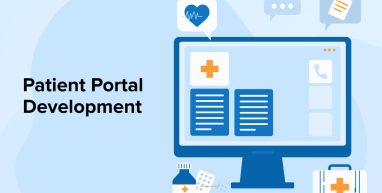
In today’s world where everything is being digitized, the healthcare ecosystem is nowhere behind. Hospitals and healthcare institutes have started adopting technologies and implementing software solutions into their systems to improve healthcare solutions. Consequently, the demand for patient portals has increased in recent years. Nowadays, many organizations have started looking for the best patient portal development companies that can help them create a custom patient portal solution for their institute.
Patient portals created by healthcare software development companies are versatile and used by hospitals to provide high-quality healthcare. The medical software not only enables better communication between the patients and the healthcare providers but also helps in building a better patient-physician relationship and giving more control of the treatment to the patients. These portals enable patients to access their healthcare data whenever and wherever they require it. They can check their prescriptions and lab results, update personal and medical information, update insurance information, and manage unpaid balances.
As per a survey from Research and Market, the adoption of patient portal software in the medical field will reach a value from $2,705 million to $5,820.88 million in 2027. The majority of healthcare officials have now started to encourage the use of multipurpose healthcare portals to digitize the important parts of the medical ecosystem.
The patient portals are used to handle clinical and administrative functions. They also enable patients to be more engaged with their doctors. To learn more about the patient portal, including its types, benefits, features, and development cost, let’s explore this blog.
1. What is a Patient Portal?
A patient portal is an online platform for patients to interact and engage with their doctors and hospitals. These portals are used by hospitals and medical service providers to offer patients timely access to their healthcare data. Additionally, they enable the patients to retrieve their lab results, update profiles, ask health-related questions, and access insurance information.
Patient portals can be useful to increase patient engagement, manage costs, promote loyalty, and streamline workflows. In addition to this, patients can schedule or reschedule appointments and pay healthcare bills directly through the portal.
Know more about Patient Portal in detail
1.1 Types of a Patient Engagement Portal
Two major types of patient engagement portals available in the market are –
1. Standalone Patient Portal
Standalone patient portals are software that support a limited number of functionalities but are highly used by healthcare institutes. This type of portal usually offers just one key function, like accessing lab test results or scheduling appointments. Additionally, the database or file storage system solution behind the portal is rarely connected to bigger systems. This means that the standalone patient portals aren’t connected to the data exchange systems like electronic health records or HMS. Standalone healthcare systems are used by smaller institutes like independent drugstores, private labs, boutique healthcare providers, and local medical officers.
In addition to this, a standalone patient portal works on simple software architecture which means that it requires less effort and investment in the overall development process of healthcare apps. Besides this, even a less-skilled programming team can develop standalone healthcare software in a shorter time. Since its development doesn’t require experts, it is normally affordable for smaller businesses.
2. Integrated Patient Portal
Integrated patient portals are also known as connected or tethered portals. These types of portals serve as an interface for larger medical systems such as an electronic health record(EHR) or hospital management system(HMS). Integrated patient portals are for the medical institutes that have big and complex systems. For bigger institutes, this type of patient portal comes with features like a direct connection to the patient’s database handled by the organization or a medical facility. Once the connection is made with the institute’s database, the software can offer a wide variety of services and functions to the healthcare providers.
Integrated patient portal systems require more time and effort to get developed and designed as they have to offer various features and they are going to be integrated into larger institutes’ existing systems. Because of this, the development cost of integrated patient portals is greater than that of a standalone portal. Besides this, this type of portal can become a part of a bigger digital transformation by involving a hospital management software development approach.
1.2 Features of a Patient Portal Software
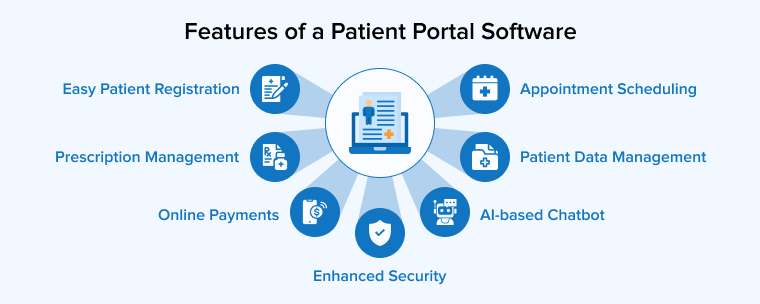
Some of the major patient portal features that are useful for both patients and hospitals are –
1. Easy Patient Registration
For any healthcare service provider, patient onboarding is one of the most important things. With the patient portal, healthcare organizations can make the registration process for patients easier.
Any hospital institute requires a proper design for the registration process as it has to be user-friendly for the patients. When a user signs in, the medical institute may request them to fill out a form to understand the user’s medical history, health lab reports, previously prescribed medication, and underlying conditions. The data gathered from the form will be stored in the patients’ profiles, potentially enhancing patient engagement.
Developing a patient portal that offers an easy patient registration process requires a multi-tier solution that can manage access as per the role of the user across the levels. Besides patient management, this medical portal also needs a supplier management system, employee management system, and partner management system. With such systems integrated into the patient portal software, tasks like managing staff, treating patients, partnering with laboratories, and getting medical supplies can be streamlined and tracked easily.
2. Patient Data Management
In any custom patient portal software, if there is a proper patient data management feature available, it can be very beneficial. This feature can offer access to patient data to the doctors, allowing them to get all the required information about the patient such as the patient’s EHRs (electronic health records), lab tests, prescription plans, and more. Even patients benefit from this feature as they get access to their medical history, current treatment, insurance details, and more.
3. Appointment Scheduling
This feature enables the patients to book their appointments from wherever they are. Such portals come with an integrated calendar that the patients can view to see if any slots for appointments are available and they can also book the appointments from the same calendar. Besides this, the appointment scheduling feature can be a game-changer as it can help the patients optimize time utilization by automatically eliminating unnecessary appointments.
4. Prescription Management
Patient portals also come with a prescription management system that is a tele-medication feature for the patients. This feature enables the patients and medical practitioners to keep track of the ongoing treatment and repeated medical procedures of the patients. It also prompts patients to refill their prescriptions if they have consulted some other doctor for an emergency. By offering such a feature to the patients, the medical institutes can expect an increase in the management of patients. Besides this, by having such software, hospitals can reduce the physical footfall at their premises.
5. AI-based Chatbot
Every patient portal solution offers real-time communication with the help of chatbots. Besides that patients must also receive personalized consultations with the help of protected chat. This feature can make the medical institute’s approach very popular as the patients get custom treatment and their information is safe and secure. For this, the patient portals must implement a live chat feature or AI-based chatbot that not only answers FAQs but also offers customized answers.
6. Online Payments
Using a patient portal will give an easily accessible platform to patients where they can clear their medical dues. This means that having a patient portal with an online payment gateway can be very beneficial for hospitals. This feature enables physicians to track down clients for overdue payments. Besides this, the online payment system in medical software can also help in managing insurance and medical claim data. Eventually, this feature can help in increasing the revenue cycle of the hospital and saving the time that goes behind a physical payment or insurance process.
7. Enhanced Security
A reliable secure patient portal app is a necessity now. With this security feature, the app carrying sensitive patient information stays secure and maintains privacy. Besides this, multi-factor authentication is a must for any digital healthcare solution as it will ensure personal data security.
1.3 Patient Portal Benefits For Medical Practices
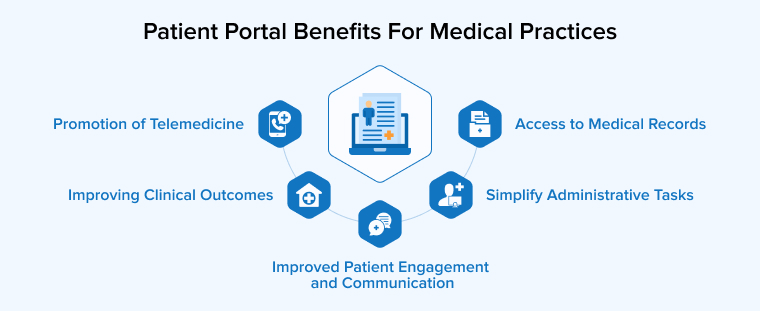
Some of the major benefits of patient portal software for medical practice are –
1. Access to Medical Records
A patient portal is an online platform offering medical record accessibility for patients. Providing capabilities like physician visit descriptions, notes and test results, they have been widely utilized in many medical workplaces.
Apart from their ease of use, patient portals may help healthcare professionals improve productivity and cut expenses. Patients with long-term illnesses can benefit the most from such portals because they give them more control over their healthcare choices.
Patients who have access to a patient portal usually express better satisfaction with their whole treatment experience; thus, technology has been proven to minimize in-person visits to the clinic. It’s also easier for them to ask for refills on medicines and to interact with their provider.
2. Improved Patient Engagement and Communication
Patient portals let people easily access their health records and interact with their clinicians. Improved patient engagement and pleasure follow from this.
The platform lets patients schedule visits, ask concerns regarding their medical issues. They can also check out their vaccination records, test findings, and doctor notes. This can enable individuals to better manage their health and make wise decisions concerning their treatment.
Users can access the site to find out more about a new drug their doctor has recommended or to inquire about a test result, for instance. The site can also provide family members or caregivers health information.
3. Improving Clinical Outcomes
Making online prescriptions and referrals is one of the most significant capabilities of Patient Portals. Portal simplicity of access allows patient compliance on a far more extensive level, and healthcare outcomes greatly enhanced as well.
On chronic conditions like diabetes, patient portals produce far more clinically significant results. Research on the subject shows that portals boost results with greater care planning, awareness among patients, and patient-health institution communication. Studies also reveal that since they remain more involved in their treatment plans, patients who may immediately access physician notes have a far greater rate of regular prescription usage.
4. Promotion of Telemedicine
Since patient platforms cut down on visits to the clinic that aren’t necessary, doctors can see more individuals who genuinely require to see them as well. This can make telemedicine—which lets patients see you via video chats or messaging system—easier.
For a change in medication dosage, for instance, the patient can ask you about it via the patient portal instead of making an appointment to visit their doctor. This function allows you to keep the slot open for a patient who either requires emergency medical attention or one with a condition that calls for a diagnosis and prescription in person.
5. Simplify Administrative Tasks
Nobody enjoys working through documentation, right? In the case of patient portals, it’s not the same. Patient portals can reduce numerous administrative complications.
Usually, you have to fill out a lot of paperwork for health care and might as well deal with insurance, submitting documents, and tracking invoices. Nonetheless, a patient portal might assist in easing this trouble.
Its key benefits for patients include the ability to pay their bills online and update their personal data and insurance details. You are not sitting on hold or racing to the clinic to deal with these issues. It frees your time and allows you to concentrate on your health, which is incredibly important.
A patient portal, all things considered, simplifies and increases convenience in healthcare. It’s all about communicating and simplifying administrative tasks to match ordering takeout. So, consider it if your doctor provides one.
1.4 Challenges of Patient Portal
There are some challenges in the Patient Portal, Including:
1. Technological Difficulties
People who don’t have an electronic device or don’t know how to use one properly have a hard time navigating patient portals, which is a major problem due to the digital divide. Addressing accessibility, and connection, and educating and supporting those with poor technological abilities are crucial to closing this gap.
2. Issues with Effective Communication
The ability to convey thoughts is one of the most important factors in providing high-quality treatment and making patients happy. Poor health outcomes can occur as a result of misinterpretation of symptoms and inaccurate diagnoses caused by communication breakdowns between doctors and their patients. Thus, the most prevalent obstacles to promoting effective communication between patients and doctors are language problems.
3. Lack of Functionalities
There are a lot of features that patient portals offer, but they might not have all that patients need. To improve the patient experience overall, this feature gap may be filled with enhancements like online appointment booking, medication refills, and secure communications.
4. Data Differences
When utilizing patient portals, patients could come across inconsistencies or missing information in their medical data. Patients may struggle to comprehend their medical records due to inaccurate data or muddled explanations of medical terminology.
2. Patient Portal Software Development Process
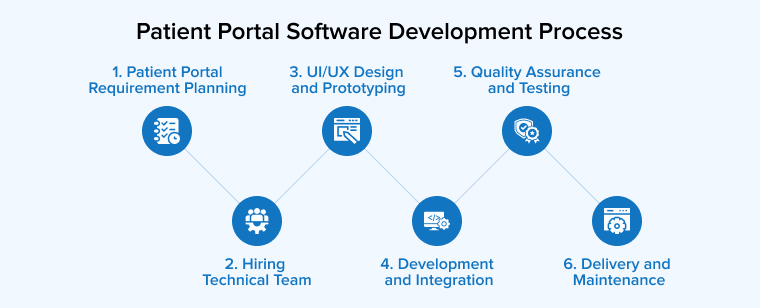
When it comes to healthcare portal development, some substantial responsibilities need to be considered and require a certain amount of preparation. To know the entire process of how to create patient portal software, let’s go through the patient portal development process:
2.1 Patient Portal Requirement Planning
One should research how achievable a patient portal software development project is before beginning it. Share your objectives, needs, and pain points with your selected software development agency seated down. It is also advisable to analyze your rivals and develop aspects that will make you unique.
Consider every good recommendation, but first perform a thorough study to develop a basic outline of your strategic road map, corporate model, and return on investment goals. This is also the time you decide if you wish for your patient portal to be integrated or independent and establish your budget. Following a market and technical study of your patient portal app concept, the development team will go on with the design.
2.2 Hiring Technical Team
After planning everything contact a patient portal software vendor that has expertise in developing patient portal solutions. If you are an owner of a hospital and are looking for a perfect tech partner, you must pay attention to various things including the number of successful projects the company has delivered, the complexity of the projects delivered, and the type of technologies used to create those custom solutions. In addition to this, one must also check the patient portal software vendors’ expertise before hiring the patient portal development service providers.
2.3 UI/UX Design and Prototyping
The next step is for the UI/UX designers to determine the important user scenarios like prescription renewal and video meetings with the doctor. The designers can create a prototype of the future patient portal solution that shows how the software is supposed to look and what it is supposed to do. The prototype will specify the capabilities of the software. Besides this, the designers will also make the user interface elements of the portal which will be appealing and intuitive. Basically, in this stage of the software development process, the designers will come up with a user-friendly and modern design for the portal.
2.4 Development and Integration
After designing, the team comes to the development and integration phase. It is the most important and challenging phase of the patient portal software development process. In this stage, the development team creates a backend and front end of the platform. They also create a mobile application if it is in the requirement. The development team integrates the required APIs into the portal. For instance, if the portal has to have a payment system, the developers will integrate an API for the online payment system. After the creation of a custom patient portal, the developers integrate it with other systems like CRM, EHR/EMR, hospital management systems, and more. This enables the hospitals to avoid any duplication of data and it also helps in minimizing the patient data management cost. So basically, the development and integration phase is the most essential part of the entire development procedure.
2.5 Quality Assurance and Testing
After the development of software, before launching it, the last step to carry out is quality assurance and testing. There is a specific team of experts who have the qualifications and capabilities to test the patient portal in both manual and automated ways. This team of testers verifies the functionalities of the product and checks whether everything is working well or not. In this stage of the development process, the main aim is to assess whether the developed platform is ready for deployment or not. The testers confirm that the portal complies with the regulatory standards and core security.
2.6 Delivery and Maintenance
The last stage of the patient portal software development procedure is to deliver the software and then offer maintenance support. In this stage, after the QA team approves the product, the software development company presents it to the customer and stakeholders for feedback. After collecting the feedback from the stakeholders and the customer, the development team makes the necessary changes if required and then delivers the product. But the work is not over here, after the deployment of the portal, the development team has to keep the product up-to-date by offering frequent upgrades, checking the data security measures, and monitoring the standard compliance. Offering such services enlarges the software lifecycle and also enables the patient portal to keep up with the dynamic market.
3. How Much Does It Cost to Develop a Patient Portal?
Let’s have a look at the cost of the patient portal development process and aspects that affect the cost –
3.1 Development Team
The most basic thing for starting the development of a patient portal with a few important features is a team of 2-3 expert software developers (one or two front-end developers and one back-end developer). Along with this, the software development team must also have a project manager and QA specialist. The cost of hiring a programmer in the U.S. is very expensive. The front-end developers’ average yearly wage is between $8k to 30k per month in the USA as per the talent and expertise of the developer. Projects like medical portals last for 3-6 months which can cost a lot. Therefore, when it comes to creating a patient portal, hospitals from foreign countries hire software development companies from India as the cost of the entire app development can be around $70-80K.
This is why medical institutes don’t prefer having an in-house app development team, rather they would outsource the development team which not only includes developers but also has project managers and QA engineers.
3.2 Duration of the Project
Another important aspect when it comes to the cost of the patient portal development is the duration of the entire project. As per the size of the development team and the technological profile, the execution process of the project can take around three to six months approximately. You can minimize the patient portal project’s duration if the software is assembled with ready solutions from different libraries or software available in the market. It can also be an integrated portal with open-source catalogs with the help of API integration and appropriate setting of components to minimize the duration of the project. However, if the hospital or medical institute wants to have a highly customized patient portal with various individualized solutions, the institute will require lengthier engagement from the software developers. This will add up to the cost of the software development process.
4. Patient Portal Development with TatvaSoft
The increasing use of online platforms in every field makes it very clear that the acceptance of the patient portals will be great and using them will offer a lot of benefits to both the medical institute and the patients. In the last few years, many medical institutes and hospitals have started using patient portals. Due to this the healthcare ecosystem has seen a tremendous rise and great results because of their vast capabilities.
Patient healthcare software has significantly contributed to streamlining healthcare services and generating greater revenue for medical institutes. By seeing its acceptance level, this enhancement keeps increasing. As mentioned in the above considerations, you might have an idea of what you want for your medical institute. If yes, then the only decision you need to make is what type of platform you require. For this, decide on which type of software design you want for the patient portal. After that hire our expert developers who can help in creating a patient portal as per your requirements.
If you are finding it difficult to choose the right software development vendor, you can consider looking at the healthcare portfolio of TatvaSoft. TatvaSoft is an expert patient portal development company that offers its services to all business requirements. The developers at TatvaSoft specialize in offering customized patient portals by keeping specific considerations of healthcare officials in mind. The healthcare management software created by the experts of TatvaSoft can help your institute level up the healthcare management workflow. So, if you want to hire the expert developers of TatvaSoft, connect with their team to digitize your healthcare services.
Know more about our Healthcare Software Development Services
5. Final Thoughts
Ever since the patient portals were first made, most of them have not been able to meet all of their users’ wants. Even though they have been around for a while! Poor user experience and too complicated integrations are the obvious reasons. With the correct partner, though, you can develop bespoke patient portal software that users would genuinely like using. If used and built correctly, you can see many benefits growing your way. A patient platform can help you make sure that patients are involved in their care and also make your workflow better if you use it correctly.
FAQ
What are the benefits of a patient portal?
Patient portal development primarily benefits patients through enhanced performance effectiveness, reduced human error possibility, enhanced epidemiologic safety, and better patient care.
What are the basic features of a patient portal?
The development of a patient portal app cannot be complete without the following features: online payment processing, encrypted secure chat, booking appointments, private profile handling of information, and user registration.
How do you create a patient portal?
If you want a patient portal built, you should choose an IT company that specializes in healthcare software development. Following that, your product will undertake the standard software development life cycle (SDLC) steps such as strategizing, examination, design, development, testing, deployment, and maintenance.


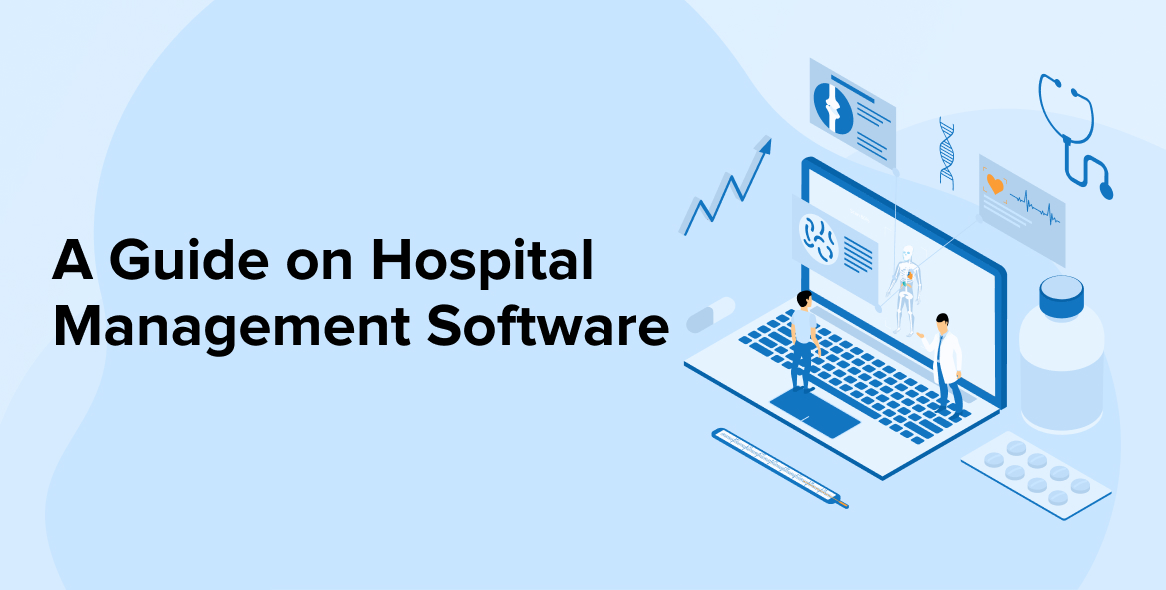
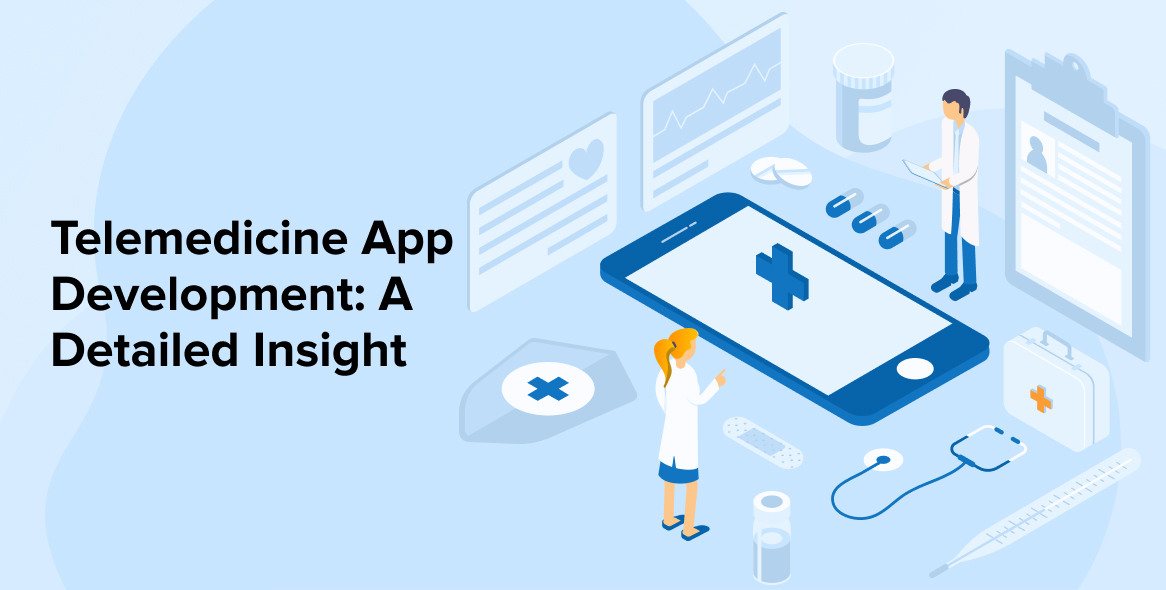
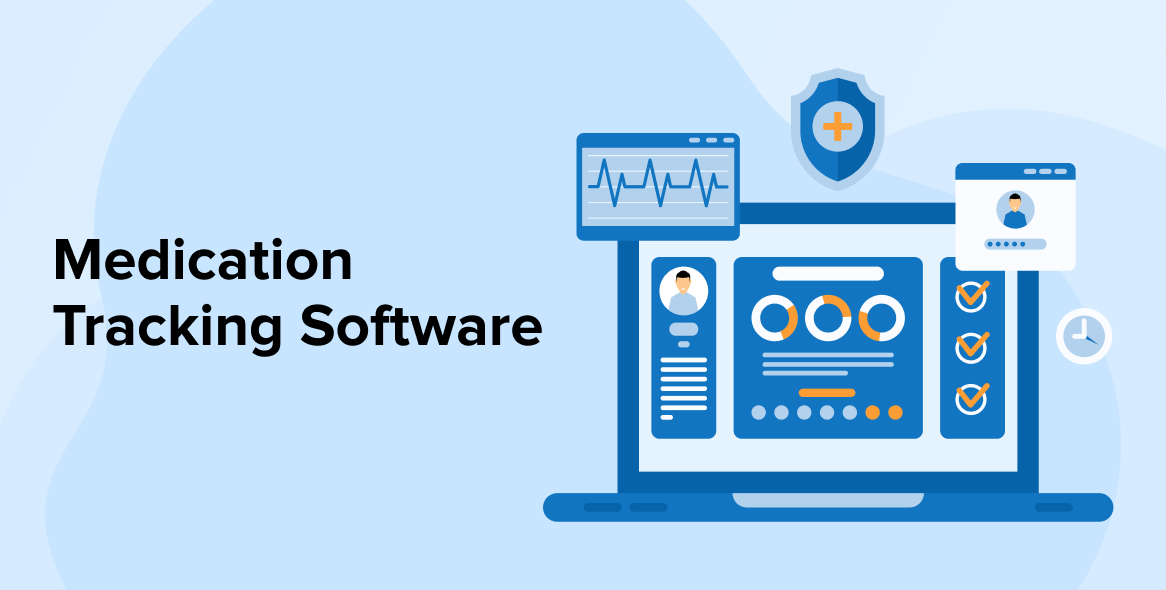

Comments
Leave a message...